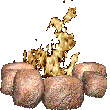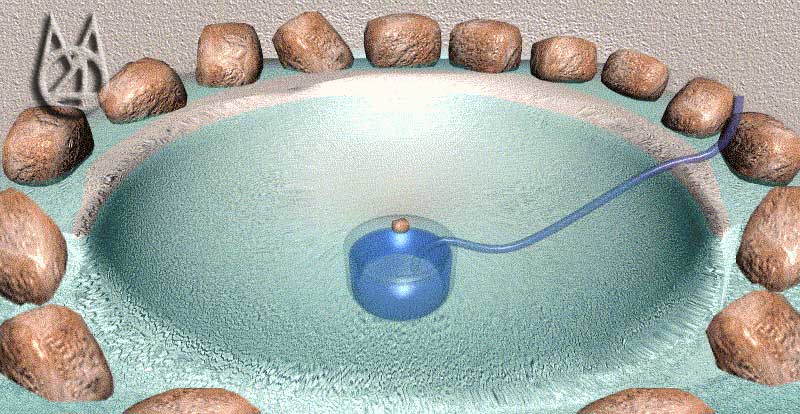 SURVIVAL SKILLS
- WATER
SURVIVAL SKILLS
- WATERAll Text, Graphics, Animations, Video, and Commentary on this website was created by, and is the intellectual property of m4040@m4040.com. All Rights Reserved. Unauthorized reproduction is punishable by up to a $500,000 fine or 5 years imprisonment for a first offense, and up to a $1,000,000 fine or up to 10 years imprisonment for subsequent offenses under the Digital Millenium Copyright Act (DMCA). Requests for use of this material should be forwarded to m4040@m4040.com. Why did I add this disclaimer? SEE WHY.
 SURVIVAL SKILLS
- WATER
SURVIVAL SKILLS
- WATER
 |
VISIT M40's WILDERNESS SURVIVAL STORE The best wilderness survival gear on the market! Backyard campers and Rambo wannabe's... go buy a Bear Grylls kit. When you get serious about your wilderness activities... come see my gear. Hikers, mountain bikers, cross country skiers, ATV'ers, off-roaders, and others whose activities carry them far and wide... discriminating outdoorsmen opt for quality gear. |
Basic water finding skills
Finding water can be an essential skill to have. A human can't live more than a few days without water. You must drink plenty of water even if you do not feel thirsty. An adult should drink at least a couple of liters per day (more in hot climates). Water can be found or readily produced even in desert conditions. For starters, aside from Saudi Arabia, I have never lived in desert areas, and would not be likely to be found hiking in a desert. The only way that I know of to obtain water in the desert is using a solar still in conjunction with whatever scrappy plant life you can locate (see instructions below). That said, my advice if you are caught in the desert is to get the hell out of the desert (hunker down in daylight, move at night).
In much of North America however, water is plentiful. In mountainous areas, just continue to walk downhill and you will eventually find water. Water obeys the laws of gravity quite well! Watch animals or follow their tracks. They will usually lead to water as well. Birds also tend to congregate near water. If you are getting water from streams or ponds, boil before drinking, or use water purification tablets. If you cannot boil it or have no purification tablets, a couple methods of finding or procuring fresh water are discussed below.
Using the Earth Itself to Filter Ground Water
The ground itself makes for a great water filter. If you are near a water source that is less than clean, use the ground to filter it. Go about 50 feet from the standing water, and dig. If your "pit" looks less than clean after you hit water, give it a few minutes, or continue scooping out water and discarding until it clears up. This same method works even for sea water. For seawater, I would move a little further inland... maybe 50 yards or more before digging. You should strike fresh water there. The further you can go without a significant increase in elevation, the better your chances of getting a good fresh water supply.
Water Filter from All Natural Materials
I kept wondering when the dumbasses on "Survivor" were going to think of this one (especially since their map of the area specifically listed a "charred log"), but apparently they immediately disqualify anyone who has more than two or three brain cells. Anyhow, this filter doesn't filter down to viral levels* or anything, but is surprisingly effective nonetheless. I plan on experimenting with clay in the future to see what I can come up with.

Constructing the Filter
This unit is housed in a hollowed out log, (see cutaway view above) rolled up bark, or whatever else you can make a tube out of (a pant leg for instance). Item 1 is the crucial part. It is crushed black charcoal (not ash). This is wood that has been charred to black, and then crushed up to sand or powder consistency. Sand is packed on either side of the charcoal (Item 2). Grass, moss, leaves or other material is packed in to help retain the sand (Item3). Finally, a rock pushed into either end to hold it all in place (Item 4). The rocks are not tight enough to seal anything, they simply keep everything in place. You can skip both the grass and rocks if you have extra fabric to tie around the ends to hold in the sand.
Once the filter is completed, water is slowly poured in from the top and allowed to filter down through. The first few gallons of water that go through will be a bit murky. Toss these, and keep pouring... it will clear right up.
Footnote: Viruses are typically not an issue in water sources unless you are traveling into tropical regions. Most viruses found in the waters of N. America are bacteriophages. They are dangerous to bacteria such as Cryptosporidium, Giardia and other single cell protozoa.... which are the critters you're trying to get rid of anyways. My point is that, if the charcoal layer is properly packed, this filter should trap the stuff you're primarily concerned about. In other areas, you will filter and then BOIL the water. The filter will take care of the murkiness, taste, etc and then the boiling will get the rest.
 Using Household Bleach to
Purify Water
Using Household Bleach to
Purify Water
Almost all laundry bleaches, whether Clorox or any other brand, have 5.5% Sodium
Hypoclorite, which is a suitable purification chemical for water. Bleach in a
suitable container with an eyedropper dispenser makes a nice addition to any
camping/survival kit. Make sure you do not use powdered, scented or other
non-pure bleaches.
Prior to the addition of bleach, remove all suspended material by filtration
(through a cotton cloth or improvised sand filter for instance) or by simply
allowing sediment to settle to the bottom.
Add 8 drops of bleach per gallon of water (or 2 drops per quart). If the water was filtered, then shake it up for even dispersal of the bleach, and wait 15 minutes. If it has sediment at the bottom, donít shake it up. Instead, allow the treated water to stand for 30 minutes.
Properly treated water should have a very slight chlorine odor. If you can't smell chlorine, repeat the dosage and allow the water to stand another 15 minutes.
For cloudy, green or really nasty water (ie:
swamp water), you can start with 16 drops of bleach per gallon of water (or 4
drops per quart). As detailed above, smell the water. If there's a faint odor of
chlorine, the water is drinkable. If not, then repeat the treatment.
Treating Larger Quantities of Water
- 1 teaspoon equals 60 U.S. drops. Therefore a teaspoon of bleach treats about
7.5 gallons of clear water or about 4 gallons of dirty water. The teaspoon
measure is handy for treating 5 gallon buckets of water.
- 1 tablespoon equals 180 U.S. drops. Therefore a tablespoon of bleach treats
about 20 gallons of clear water or about 10 gallons of dirty water.
- 1/4 cup equals 720 U.S. drops. Therefore a quarter cup of bleach treats about
90 gallons of clear water or 45 gallons of dirty water.
(a quarter cup measure is suitable for use in a 55 gallon drum of fairly dirty
water).
How Does Bleach Work? (and
why the smell test?)
Bleach is an oxidant, and it will react with and kill pretty much any
microscopic cellular life (including viruses) that it comes in contact with.
When it reacts, the bleach is actually consumed in the process.
Because killing microorganisms also consumes the bleach, the scent test tells
you whether or not there's anything left to kill. If there's no chlorine odor,
then all of the bleach was used up, meaning there could still be living
organisms. If there is a chlorine odor, however faint, after 30 minutes, it
tells you that all of the bacteria, viruses and other nasty stuff is dead, and
the bleach has done it's job with some to spare.
Solar Still
A solar still is a fairly efficient way to collect moisture from the soil. As you can see in the two views below, a tarp is draped over a hole in the ground. This is sealed in place with rocks, logs, sand or whatever is available. Make sure it is well sealed. The sun on the tarp heats the air underneath, which causes moisture in the soil to evaporate. This moisture has no place to go and condenses on the tarp itself. Because of the pebble in the middle, there is a sufficient slope for the condensate to run down the inside, and drip into the collection vessel.

A view from the top. From this angle, you can see the pebble in the middle, centered over the collection vessel.

Notes
The collection vessel can be anything... cup, bowl, tin can, another section of tarp, even a large leaf.
The drinking tube shown in the pictures is a nice addition, but not absolutely necessary. You can always lift the corner, reach in and remove the collection vessel every so often. It's more work, but if all you have is a tarp, then it may be necessary.
If the ground itself is not yielding enough water, try tossing in vegetation. It doesn't even matter if the vegetation is edible or not, as you are effectively distilling the water. The water that is collected from a solar still is 100% pure, drinkable H2O, and does not require boiling.
Final Word
In closing, I would like to mention that there is quite a lot of misleading information out there. I saw one site that told people how to make a "divining rod". These supposedly show you where to dig to find water. Their claims indicated that this was done with mystical psychic energy or some such crap. This is all part of the "new-age" line of Birkenstock bullshit that many out there seem eager to shovel on the unwitting. Do NOT listen to granola-headed shrub cuddlers when it comes to survival info. They will get you killed. The day I see the headline "Psychic Wins Lottery" will be the day I rethink my opinion of these charlatans. Wilderness Survival is all about using common sense, not a "sixth sense". I recently had someone write to me, telling me that I am wrong on the "divining rod" subject. Click HERE for my response!
FM 21-76 US ARMY SURVIVAL MANUAL
I will add to this page as often as I have time, but if you want the original be-all and end-all source of survival information, it is the FM 21-76 US ARMY SURVIVAL MANUAL. I have crunched it all into an MS Word Document. I abridged it only by removing the Appendixes from the end. It is 233 full size pages in all, and the overall file size is about 2.5Mb, so it is relatively easy to download. Whereas your tax dollars paid for it already, please feel free to distribute it as you see fit. Simply RIGHT CLICK HERE and select "Save As" to Download.
Don't have MS Word? They give away the viewer for free HERE
HELP SUPPORT THIS SITE - M40 SURVIVAL KITS ON SALE NOW!
FORUM 'RULE OF THREES'
Short Version - (1) Be Topical. (2) Be Original. (3) Be Nice.
Long version:
(1) Stay on topic - If the discussion wanders off topic or into
nonsensical rambling, I will remove your comments. Repeated abuse will result in
you being banned from posting here. If you post blatant spam here, I will ban
you from this forum AND... I will submit you for removal from ALL Disqus forums.
(2) Be original in your postings. I will not tolerate lengthy cut and pastes,
especially if you are not the author of said material. There is such a thing as
copyright law, and I will quickly ban those who attempt to pass off the writings
of others as their own.
(3) Please be nice... we all know what this means. I will not let those with
"internet balls" turn my forums into gripe sessions, heated arguments or
slanderous turd-hurling contests. There are no stupid questions... (okay maybe
there are, but please remember that not everyone is a "survival expert").
Therefore, all questions should be considered valid as long as they meet the
criteria of rules 1 and 2.
FORUM - M40 Discussion Forum - WATER - NOTE - For discussion on a different subject, please navigate to that subject's page and use that forum!
HELP SUPPORT THIS SITE - M40 SURVIVAL KITS ON SALE NOW!
All Text, Graphics, Animations, Video, and Commentary on this website was created by, and is the intellectual property of m4040@m4040.com. All Rights Reserved. Unauthorized reproduction is punishable by up to a $500,000 fine or 5 years imprisonment for a first offense, and up to a $1,000,000 fine or up to 10 years imprisonment for subsequent offenses under the Digital Millenium Copyright Act (DMCA). Requests for use of this material should be forwarded to m4040@m4040.com. Why did I add this disclaimer? SEE WHY.